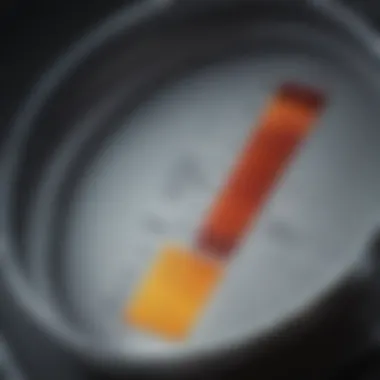Understanding the Double Ring Infiltrometer


Intro
The double ring infiltrometer is an essential device in the fields of hydrology and soil science. It measures soil infiltration rates with accuracy, providing invaluable data for various applications. Understanding its functionality and methodologies is crucial for professionals who seek to manage soil water effectively. This guide will take a deep dive into the workings and significance of the double ring infiltrometer in different environments.
Key Findings
Major Results
Research indicates that using a double ring infiltrometer can significantly enhance the measurement precision of infiltration rates compared to single ring methods. The design of the double ring reduces the effects of lateral flow, allowing for a more reliable assessment. This method is particularly important when evaluating soil properties in areas with heterogeneous soils or in managing water resources accurately.
Discussion of Findings
Many studies highlight that the efficiency of water use in agriculture heavily relies on accurate infiltration measurements. The double ring infiltrometer provides insights that enable better predictions of water movement within the soil, benefiting crop production and conservation efforts. Additionally, it aids in assessing the impacts of land use changes on hydrological cycles, thereby offering crucial data for ecological studies as well.
Methodology
Research Design
The studies conducted utilizing the double ring infiltrometer often employ a field-based research design. This ensures that the measurements taken are representative of real-world conditions. Researchers utilize a systematic approach for placing the infiltrometer, ensuring consistent data acquisition under varying environmental conditions.
Data Collection Methods
Data collection involves filling the outer ring with water while monitoring the inner ring. The rate at which water infiltrates into the soil is recorded at regular intervals. This allows for the analysis of how different soil textures influence infiltration rates. The collected data is vital for validating models of water movement and soil moisture dynamics in various contexts.
Accurate infiltration data helps in designing efficient irrigation systems, promoting sustainable practices in agriculture.
Prelude to the Double Ring Infiltrometer
The double ring infiltrometer is a vital instrument in hydrology and soil science, used extensively to measure the rate of water infiltration in various types of soils. Understanding its significance is essential for effective soil water management, agriculture, and ecological research. This section aims to present the core elements and advantages of utilizing the double ring infiltrometer, which serves as an essential tool for both researchers and field practitioners.
Overview of Infiltration Measurement
Water infiltration is a critical process influencing soil moisture content, crop productivity, and groundwater recharge. The infiltration rate can vary widely depending on soil texture, structure, and condition. The double ring infiltrometer provides a more accurate assessment of infiltration rates compared to older methods. It consists of two concentric rings, which allows for consistent measurement of water entering the soil.
The design minimizes the lateral flow of water, focusing on vertical movement, thus enhancing data reliability. This instrument's ability to deliver precise infiltration data helps in making informed decisions about irrigation practices and soil conservation strategies.
Infiltration measurement is fundamental in several fields. This includes agricultural planning, hydrological modeling, and designing drainage systems. Various studies indicate that accurate data helps improve water management practices, aiding in both economic and environmental sustainability.
History and Development
The development of the double ring infiltrometer can be traced back to the early 20th century when interest in soil water dynamics began to gain momentum. While single-ring infiltrometers were in use prior, they exhibited limitations due to their inability to accurately account for lateral flow and edge effects, which can lead to skewed data.
The introduction of the double ring design addressed these issues, resulting in increased accuracy in measuring infiltration rates. Over the decades, modifications and improvements were made to its materials and design based on emerging research and field applications. Today, the double ring infiltrometer is recognized as a standard tool for measuring soil infiltration globally.
Design and Components
The design and components of the double ring infiltrometer are fundamental elements that contribute to its effectiveness as a tool for measuring soil infiltration rates. Understanding these components enables users to better appreciate their functionality and application in various contexts, such as soil science and hydrology. This examination also highlights the critical aspects that influence the accuracy of the infiltration measurements, thus aiding in the selection and use of the device.
Structure of the Double Ring
The double ring infiltrometer consists of two concentric rings, the outer and inner rings. The primary purpose of this structure is to create a controlled environment for measuring how quickly water infiltrates into soil. The outer ring prevents lateral flow of water, ensuring that all measurements reflect vertical infiltration only. Often made adjustable, this design allows users to customize the diameter of the rings based on specific field conditions. Such adaptability is crucial, as different soil types and moisture levels can significantly impact infiltration rates.
Furthermore, the height of the rings must be sufficient to contain water without overflowing. A proper height ensures accurate readings and prevents confusion caused by surface runoff.
Materials Used


The materials selected for constructing the double ring infiltrometer directly influence its durability and performance. Commonly, the outer and inner rings are made from materials like stainless steel or plastic. Stainless steel offers remarkable strength against corrosion, which is beneficial for fieldwork, especially in wet or saline conditions. On the other hand, plastic versions may be lighter and more cost-effective, but might lack the robustness required for certain environments.
In addition to the rings, it is important that the infiltrometer has a reliable measuring device, often in the form of graduated measuring tubes or electronic sensors, allowing for precise water level measurement. Using high-quality materials ensures that the infiltrometer can withstand repeated use and various environmental conditions without losing its functional integrity.
Operational Features
The operational features of the double ring infiltrometer significantly enhance its utility in field measurements. The staggered deployment of the inner and outer rings facilitates a more effective infiltration test by maintaining soil moisture at specific zones around the inner ring.
This feature permits more accurate readings because it minimizes horizontal seepage that could skew results. After initial deployment, water is added to both rings, and careful observation of the water level drop in the inner ring over a specific period allows for calculating the infiltration rate.
The ability to track changes in infiltration rates over time offers valuable insights for understanding soil properties and management practices. This is particularly useful in fields like agriculture, where knowing how quickly water infiltrates informs irrigation strategies. Ultimately, the design, materials, and operational features make the double ring infiltrometer a robust tool for researchers and practitioners alike.
Operational Methodology
Operational methodology is critical in effectively utilizing the double ring infiltrometer. This section addresses crucial elements such as the rationale for choosing proper sites for testing, the steps for correct installation, and the precision of the measurement process. Understanding these components not only enhances the reliability of the data but also informs best practices for various applications in hydrology and soil science. Effective methodology ensures that results are accurate and can be replicated, thus providing valuable insights into soil infiltration dynamics.
Site Selection for Testing
Selecting the right site is foundational for obtaining valid infiltration measurements. Factors to consider include soil type, land use, and moisture conditions. Different soils respond variably to infiltration tests. Therefore, a homogeneous area with representative soil characteristics should be aimed for. Typical locations might be agricultural fields, natural forests, or urban green spaces.
"The choice of site significantly influences the outcome of infiltration tests. Ensure conditions mimic the study's intended application."
Prior to testing, analyze soil texture and structure. This analysis can be achieved through soil sampling and laboratory tests. It is also essential to check if the site experiences disturbances from nearby activities, which could alter infiltration rates. Assessing these elements early helps in making informed selections that will yield meaningful results.
Installation Procedures
The installation phase is crucial for ensuring proper functioning of the double ring infiltrometer. Begin by clearing the selected area of debris and vegetation to minimize interference with readings. Using a spade, create two concentric ring depressions in the soil: the outer ring typically has a larger diameter than the inner one.
Align the rings so that they are level. Ensure that the bottom surfaces are flat to prevent leakage or uneven water distribution during the test. After placing the rings, fill both with water and allow them to saturate for a period. Proper installation minimizes errors in measurements caused by improper setup, thus enhancing data integrity.
Measurement Process
The measurement process follows the installation. This involves observing the drop in water levels over time within the rings. Start the timing as soon as water is added. The measurements should be taken at regular intervals to track the rate of infiltration accurately. It's important to note that the outer ring measures the lateral flow while the inner ring focuses on vertical infiltration. This dual approach allows for a more comprehensive understanding of how water interacts with the soil.
Records should be meticulously kept regarding the time and water levels. Use consistent units of measurement to ensure comparability. Subsequently, data collected through this monitoring will aid in analyzing infiltration rates under various conditions.
In summary, understanding the operational methodology related to site selection, installation, and measurement process is vital. This comprehension directly affects the quality of infiltration data obtained, further influencing research outcomes in hydrology and soil science.
Data Collection and Analysis
Data collection and analysis are pivotal in effectively utilizing the double ring infiltrometer. Understanding infiltration rates is necessary for various applications, including soil water management and agricultural research. Proper data collection ensures that accurate readings are taken, and effective analysis allows for meaningful interpretations that inform subsequent actions.
Recording Infiltration Rates
Recording infiltration rates with the double ring infiltrometer entails a systematic approach to capturing data during field tests. The dual-ring setup creates two distinct zones for the water to infiltrate into the soil. It is essential to regularly measure the change in water levels in both rings over time to determine the infiltration rate accurately. Over a set period, usually characterized in minutes or hours, observers should note the depth of water in each ring at scheduled intervals. This data provides a comprehensive view of how quickly water penetrates the soil, reflecting its physical properties.
Key elements to consider during this process include:
- The soil type and its existing moisture content, which significantly affect infiltration rates.
- Weather conditions during the test, as precipitation or evaporation can skew results.
- The proper calibration of the equipment, ensuring consistent and reliable readings.
Consistent and precise recording techniques increase data reliability and validity, enabling researchers to draw accurate conclusions based on observed trends.
Data Interpretation Techniques
After recording the infiltration data, researchers must interpret the collected information. Several techniques exist for analyzing infiltration data, each suited to different requirements and contexts.
One common method is the use of graphical representations, which allows trends in infiltration rates to be easily visualized. For instance, plotting infiltration data over time can reveal patterns that may indicate soil structure or compaction issues. Additionally, statistical models or equations, such as Horton’s equation, can facilitate the estimation of infiltration capacities based on the established rates observed during testing.


A careful examination of the raw data also includes identifying outliers or anomalies that may indicate errors during the testing process. An efficient interpretation process aids in understanding larger soil and water dynamics at play.
Common Data Analysis Software
Several software programs can assist in managing, analyzing, and visualizing infiltration data collected from the double ring infiltrometer. Utilizing these tools can greatly enhance the efficiency and accuracy of data processing.
Some widely used options include:
- R: This is a programming language and active environment used for statistical computing and graphics. Researchers can utilize various packages within R, specifically designed for hydrological analysis.
- MATLAB: Known for its advanced mathematical and statistical functions, MATLAB is valuable for more complex data analysis tasks.
- Excel: While basic, Microsoft Excel remains widely used due to its straightforward functions for data organization and quick calculations. Data can be easily imported and charts generated to visualize trends.
Employing these tools effectively highlights important infiltration characteristics and provides deeper insights into soil behavior under varying conditions.
The integrity of observation methods and subsequent analyses directly influence the quality of conclusions drawn in hydrology and soil science.
By ensuring meticulous data collection and employing robust analysis techniques, researchers can foster improved understanding and better management of soil and water resources.
Applications of the Double Ring Infiltrometer
The double ring infiltrometer serves a pivotal role in various fields, particularly in soil science and hydrology. Understanding its applications provides insight into how this tool contributes to sustainable practices and research efforts. Its utility spans multiple domains, from promoting soil conservation to enhancing agricultural productivity. The flexibility of the infiltrometer allows for diverse applications, depending on the objectives of the research and the environmental conditions.
Soil and Water Conservation
Soil and water conservation are crucial for maintaining ecosystem health. The double ring infiltrometer assists in assessing how much water a specific soil type can absorb. This knowledge guides conservation practices by identifying areas prone to erosion or runoff. For instance, farmers and land managers can determine optimum planting practices or implement targeted water management strategies based on infiltration rates. By measuring the effectiveness of various conservation techniques, such as cover cropping or no-till farming, stakeholders can make informed decisions that enhance soil quality and preserve water resources.
Agricultural Research
In agricultural research, the double ring infiltrometer is invaluable for understanding soil-water interactions. Researchers use it to establish baseline data on infiltration rates, which are essential for evaluating crop water needs. Different soils respond uniquely under similar conditions, so using the infiltrometer provides accurate insights into the efficiency of irrigation systems. Moreover, it aids in identifying the best times for irrigation, ultimately improving water use efficiency. With sustainability being a priority, agricultural scientists benefit from this tool as they develop methodologies that minimize water waste and improve yields.
Hydrological Studies
Hydrological studies leverage the capabilities of the double ring infiltrometer to understand surface and groundwater interactions. This tool can help model how water moves through soil profiles, influencing local hydrology and ecosystem functions. Data gathered can inform water resource management strategies or flood prevention measures. In areas prone to flooding, understanding the rate of infiltration helps predict where water will accumulate, allowing for effective planning and response. Thus, the double ring infiltrometer is vital for studying water cycle components and ensuring sustainable management of water resources.
"Infiltration measurements are essential for effective water management and land-use planning."
The applications of the double ring infiltrometer demonstrate its importance across various domains. Its effectiveness in soil and water conservation, agricultural research, and hydrological studies showcases its versatility as a critical tool. As environmental challenges increase, the role of this infiltrometer in research and practical applications becomes even more significant. By comprehensively analyzing its applications, professionals can contribute to sustainability and informed decision-making.
Advantages and Limitations
Evaluating the effectiveness of a double ring infiltrometer encompasses a critical discussion of its advantages and limitations. Understanding these aspects is vital for researchers, educators, and professionals aiming to make informed decisions regarding soil infiltration measurement. The balance of its benefits against its shortcomings provides insights into its practical applications and guides future research in soil and water management.
Benefits of Using a Double Ring Infiltrometer
The double ring infiltrometer, as an advanced tool for measuring soil infiltration, offers several notable benefits:
- Accuracy: The design minimizes errors related to lateral flow of water, which can distort measurements from a single ring. This leads to a more precise assessment of infiltration rates.
- Versatility: It can be used across various soil types and environmental conditions, making it a valuable tool for a range of studies including hydrology and agronomy.
- Ease of Use: While some training is required, the installation and operation of the double ring infiltrometer do not demand extensive technical skills. This accessibility allows for broader application in field studies.
- Comprehensive Data: Utilizing a dual ring system allows for simultaneous measurement of infiltration and helps in understanding water movement in different soil layers,
- Enhanced Research Opportunities: Its reliability aids long-term studies on soil water dynamics, contributing to better management practices in areas such as agriculture and watershed management.
Challenges and Limitations Encountered
Despite its benefits, using a double ring infiltrometer presents several challenges:
- Site Specificity: Infiltration results can significantly vary from one location to another. Site-specific factors, such as vegetation and soil compaction, can impact the measurements.
- Resource Intensive: The process can be time-consuming and may require considerable water, especially in dry environments, which could limit its feasibility in water-scarce regions.
- Maintenance and Calibration: Regular maintenance is crucial for ensuring accurate measurements. Calibration can be complex, especially in heterogeneous soils.
- Environmental Effects: External factors like soil moisture content and recent weather conditions can influence the infiltration rates, which can complicate the interpretation of data.
- User Error: Improper installation or failure to follow standard procedures when setting up the infiltrometer may lead to inaccurate data, which diminishes the tool's credibility.
Understanding both advantages and limitations is essential for maximizing the effectiveness of this crucial method in scientific research and practical applications.
Comparative Analysis with Other Methods


A comparative analysis with other methods for measuring soil infiltration is crucial for a comprehensive understanding of the double ring infiltrometer's efficacy and applicability. This section focuses on two primary alternatives: the single ring infiltrometer and tension infiltrometers. Understanding their differences, advantages, and limitations can guide researchers and professionals in selecting the most suitable method for their studies.
Single Ring Infiltrometer
The single ring infiltrometer is a simpler version of its double-ring counterpart. It consists of a single ring inserted into the soil, and water is applied to measure how quickly it infiltrates.
Advantages:
- Simplicity: This method is easier to set up and requires less sophisticated equipment.
- Cost: Generally, a single ring is less expensive to construct and operate.
- Space Efficiency: It is ideal for smaller plots where space is limited.
Limitations:
- Edge Effect: Water can flow horizontally from the moist area to drier soil, which can skew results. This effect can lead to less accurate infiltration readings compared to the double ring method, which minimizes lateral flow.
- Less Reliable: Under certain conditions, the single ring may yield less consistent results, especially in heterogeneous soils.
Tension Infiltrometers
Tension infiltrometers measure soil infiltration under controlled tension, providing insights into water movement in the soil. The method involves using a water-filled tension chamber that applies a suction to the soil.
Advantages:
- Precise Measurements: Tension methods can offer more accurate data regarding soil water retention and movement, especially in unsaturated soils.
- Depth of Measurement: These infiltrometers often allow the measurement of infiltration rates at different depths, providing a more comprehensive picture of soil water dynamics.
Limitations:
- Complexity: Setting up a tension infiltrometer requires more technical knowledge and is generally more complex than using a single ring.
- Cost Factors: They can be significantly more expensive to acquire and maintain, limiting their use in some studies.
A thorough understanding of these methods enables users to make informed decisions that affect the accuracy and reliability of their infiltration assessments.
In summary, the comparative analysis reveals that while each method has its unique strengths, the double ring infiltrometer typically outperforms both the single ring and tension infiltrometers in terms of accuracy and reliability for most applications. Choosing the appropriate method largely depends on the specific goals of the study, the characteristics of the soil, and the resources available.
Future Directions in Infiltration Research
Exploring future directions in infiltration research is vital for advancing our understanding of water movement in soil. As environmental challenges increase, innovative solutions are necessary to accurately measure and manage soil infiltration rates. This section outlines key innovations and integrations that promise to enhance current methodologies and applications of infiltration research.
Innovations in Measurement Techniques
Measuring soil infiltration has seen significant advancements in techniques and technologies. Traditional methods, while effective, often lack the precision and flexibility required in modern research contexts. Recent innovations focus on improving measurement accuracy, efficiency, and accessibility.
- Automated Infiltration Systems: These systems can continuously record infiltration rates over extended periods. They reduce human error and increase data reliability. By using sensors and data loggers, researchers can monitor conditions in real time, adjusting methods as needed based on immediate observations.
- Multi-Depth Measurement: New approaches allow for infiltration measurement at various soil depths. This insight helps researchers understand vertical water movement better, crucial for evaluating deep-rooted plants or aquifer recharge.
- Real-Time Data Analysis: Integrating advanced software with infiltration measurement tools leads to quicker data analysis. It streamlines workflows and helps researchers make informed decisions on-site, impacting both research outcomes and practical applications.
Integration with Remote Sensing
The application of remote sensing technologies in infiltration research opens new dimensions for understanding soil moisture dynamics. The synergy between ground measurements and aerial data collection can enhance overall research quality and efficacy.
- Satellite Imagery: Satellite data provides macro-level insights into soil moisture content across vast areas. By correlating this information with ground-based infiltration data, researchers can identify patterns and variations in infiltration rates driven by different land uses or climatic conditions.
- Drones and UAVs: Unmanned aerial vehicles can capture high-resolution images of the landscape. They help create detailed maps of moisture retention and infiltration across various terrains. This capability allows for targeted assessments and tailored conservation practices.
- Geospatial Analysis: Combining remote sensing with Geographic Information Systems (GIS) enables in-depth spatial analysis. Researchers can evaluate infiltration patterns relative to topography, vegetation cover, and land management practices, leading to more informed decisions regarding land use and water conservation.
Conclusion: The future of infiltration research lies in the convergence of innovative measurement techniques and advanced remote sensing technologies. This integration will not only yield richer datasets but also empower researchers and practitioners to address urgent environmental challenges with greater efficacy.
Culmination
The conclusion serves as a vital component of this article, encapsulating the essential takeaways regarding the double ring infiltrometer. Understanding how this tool operates, its applications, and the intricacies involved in its usage is crucial for professionals in hydrology and soil science. The depth of knowledge presented throughout the article enables researchers to make informed decisions when employing this method.
Summary of Key Points
In this article, we focused on several critical aspects of the double ring infiltrometer:
- Functionality: The double ring infiltrometer measures soil infiltration rates precisely, contributing to the understanding of water movement in soil.
- Design: A detailed examination highlighted its structural elements and the materials used.
- Methodology: The operational processes for site selection, installation, and measurement were outlined, emphasizing the precision required.
- Data Analysis: Key techniques for interpreting the collected data were discussed.
- Applications: The tool's role in soil conservation, agricultural research, and hydrological studies reinforces its importance across various fields.
- Advancements: The future directions in infiltration research, particularly with innovative measurement and remote sensing integration, were also considered.
Implications for Future Studies
The findings from this article suggest clear implications for future research. Ensuring accurate infiltration measurements can lead researchers to better water management strategies. As ecological concerns increase, understanding soil-water relationships with precision becomes more critical. Additionally, future studies can explore the integration of double ring infiltrometers with technology, such as remote sensing, to enhance data collection and analysis.
Further inquiries could focus on developing more robust models predicting soil behavior under different conditions. This could significantly impact agricultural practices and soil conservation efforts, leading to more sustainable land management solutions.



